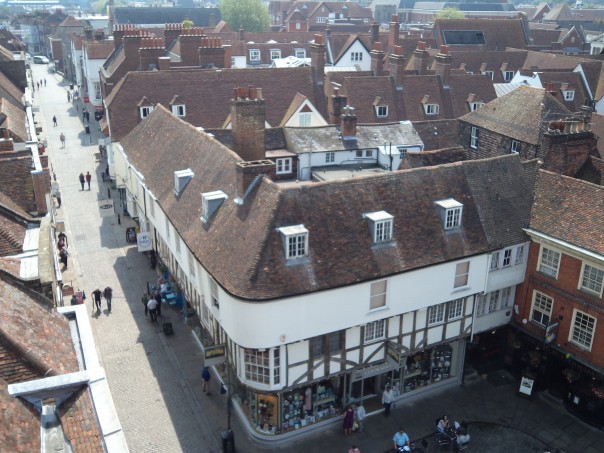Now that we are into October, it is great to report that the School of Humanities’ taught Masters degrees in both Modern History and Medieval and Early Modern Studies are up and running, which is in addition to a taught Masters in English Literature. There may be others but these I know about. The reason I mention it is that my option module group, who are studying late medieval and Tudor Canterbury, might be said to be benefitting from the Centre’s presence at Canterbury Christ Church. For those who may be interested, we had an enjoyable and instructive walk through ‘medieval and Tudor Canterbury’ last Wednesday and will be exploring the city’s topography through maps this week.
In many ways, this picks up the ideas of place and space that Professor Peter Vujakovic discussed in the Nightingale Lecture last week; and it is a thread that will again run through the blog this week. One of the reasons for this is that on Monday evening I attended, as did Dr Martin Watts, a meeting organised by Harold Goodwin of the Faversham Society about the possible future uses of T.S. Hazard. This 15th-century ‘warehouse’ is a gem in Faversham’s townscape and would seem to offer considerable potential as the location for a museum dedicated to the town’s maritime/trading heritage that worked in harmony with the building’s history. At present, the building is owned by Swale Borough Council and is the home of the local sea cadets, albeit it is far from ideal for their purposes and this use may not be particularly good for a 500 plus-year-old building either.
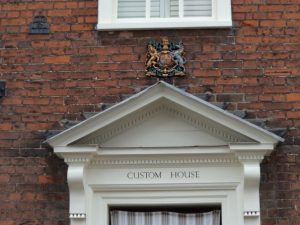
Custom House, Faversham
Perhaps not surprisingly considering the strength of local history and archaeology in the town, the meeting room at the Faversham Society’s Fleur-de-Lis building was very full when the meeting began with Harold’s resume covering TS Hazard’s recent history. He then handed over the baton to the town’s historian Dr John Owen who spoke about the range of borough, county and national records available which cover Faversham’s trading history through the ages, among other topics. John was very keen to point out that even though Faversham had been a market town from way before the Norman Conquest, it was the creek and thus shipping and other activities that had been the town’s life’s blood for centuries. Indeed, it is only in the last few decades that this symbiotic relationship with the sea (estuary) has been broken with the loss of almost all of the carrying trade to road and rail, if it happens at all. For many current Faversham residents and visitors it is the market place and Guildhall that is the ‘centre’ of town, the creek having become a very poor second.
Yet, as John highlighted, Faversham’s role as a supplier to London can be traced back centuries, for example agricultural produce – wheat, barley, malt, and from the early 14th century wool that came from Romney Marsh via Ashford to be shipped up to London. Faversham as a malt-producing and shipping town was extremely important, and in the 17th century the town was home to 17 maltsters. Not that everything was destined for London, and oysters were shipped to the Netherlands as well, but London did take much of the gunpowder and construction materials – bricks and cement, made locally. In addition, some goods passed through Faversham’s ‘hands’, including commodities such as cheese from Ipswich in the 17th century, and stone from Portland and the Channel Islands.
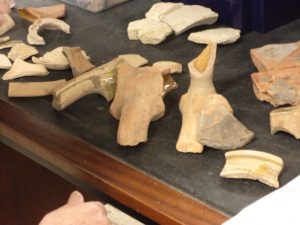
Finds from archaeological excavations – Faversham creek (thanks to the Faversham Society Archaeological Group).
John next described the town’s demographic history before turning to the town’s two quays, known from the 16th century, the first reference to the town’s two cranes coming from the 1420s. As he said most is known about ‘The Quay’, which was in private hands until it was presented to the town by Henry Hatch, entrepreneur, mayor and leading citizen. In contrast, the Standard Quay, although often said to be part of Faversham Abbey’s property portfolio, is not mentioned in the Valor, which suggests it was insignificant until apparently acquired by Thomas Arden in the mid 16th century, who met a grisly end in his own house – see the Elizabethan play, some of which is now thought to have been penned by William Shakespeare. About a century later it was acquired by the Sondes family who equally saw its commercial value, the leasing of quays a ‘good money-spinner’ in towns where trade was king.
Nor was it just the lessors and lessees who benefitted from Faversham’s trading networks, and perhaps a third of the population owed its livelihood to the creek in one form or another – fishermen, mariners, hoy men, various labourers, those making ropes, carpenters etc. Even though much of what might be called this unregulated trade escaped recording in the archives, Faversham is fortunate that among the surviving records there are Port Books (a source deployed by Dr Stephen Hipkin, a former head of the Centre, now retired, in his study of the early modern grain trade), the earliest (accounted with Sandwich) dating from the early 14th century.
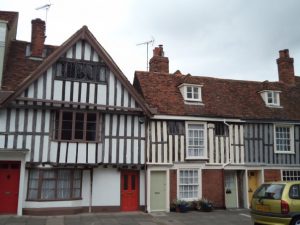
Abbey Street, Faversham
Having thanked John for this fascinating and useful summary of Faversham maritime heritage, Harold opened the discussion by asking Stuart Bligh from the Royal Museums Greenwich about the possibility of the Graveney boat returning to Faversham to the proposed museum. This started a lively debate regarding how and where it might be displayed, as well as the problems that might be encountered, especially TS Hazard being prone to flooding and the sheer size of the Graveney boat relative to the space available. Indeed, among a large part of the audience the potential of the building to become a museum largely seemed to be a given, albeit those representing the sea cadets were keen to make sure they received suitable alternative accommodation before anything further was decided and John Owen had hoped the discussion would focus on the themes that might be articulated through the museum. Concerning the latter, this didn’t really materialise beyond the Graveney boat, and at the end of the meeting almost all the discussion might be said to have been on practicalities. Yet it was great to see the obvious enthusiasm around the room and it will be interesting to see what happens next, that is after the completion of the architectural survey of the building by Canterbury Archaeological Trust that has been commissioned by Swale Borough Council as part of its duty of care to TS Hazard. For amongst other considerations, this ‘museum’ has the potential to showcase the histories of people – those who lived, worked, played, worshipped and died within Faversham’s maritime communities, especially for the centuries that saw this building come into existence and for the centuries when it was perhaps most used, possibly the period from about 1300 to 1600.
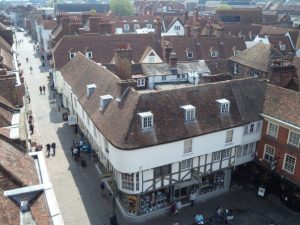
Canterbury – looking down Burgate
Keeping with the concept of place and space, I thought I would finish by drawing your attention to Canterbury Christ Church’s offering to the ‘Being Human Festival 2018’:
https://beinghumanfestival.org/ where CCCU’s contribution is led by Professor Carolyn Oulton. In terms of the Centre, I met up with Dr David Hitchcock in History and Dr Chris Price in Music yesterday (Michelle Crowther from the Library will also be involved). David is leading our ‘Criminal Canterbury in Early Modern Times’ walk on Tuesday 20 November between 10.00 and noon. He and I will do the talking and Chris’ students will provide the singing/music. Without giving too much away, the walk starts at the Westgate Towers, Canterbury city’s prison from the later Middle Ages, and ends at the ‘Old Prison’ in Longport, now part of Canterbury Christ Church. Along the way there will be three (or four) intervening stops potentially involving information and stories about justice and those who were on the receiving end, whether we are talking about debtors, traitors, petty criminals or vagabonds, as well as introducing those attending the walk to contemporary ballads and other songs. Tickets are free, but you do need to register if you think this is for you. We shall look forward to seeing you.
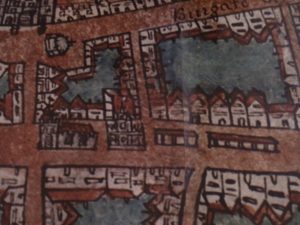
Central Canterbury – St Andrew’s church to Buttermarket
After the walk there will be a creative writing workshop at the ‘Old Prison’ and Carolyn is also organising and co-ordinating other activities at Folkestone and Margate. And remember this is the week after the ‘Exploring Kentish Naming Practices’ conference on Saturday 17 November at Old Sessions House on CCCU’s Canterbury campus. Tickets for this are selling well and more details are available at: https://www.canterbury.ac.uk/kent-names again we would be delighted to see you.
As a postscript, I should like to mention that Professor Jackie Eales will be running a workshop this Saturday for local school teachers on RAF 100 in conjunction with the Historical Association head office. This is an excellent link bringing together secondary schools in the Canterbury area, the university and the Historical Association, which has plenty of exciting material on its website.
 Centre for Kent History and Heritage
Centre for Kent History and Heritage Sheila Sweetinburgh
Sheila Sweetinburgh 1682
1682